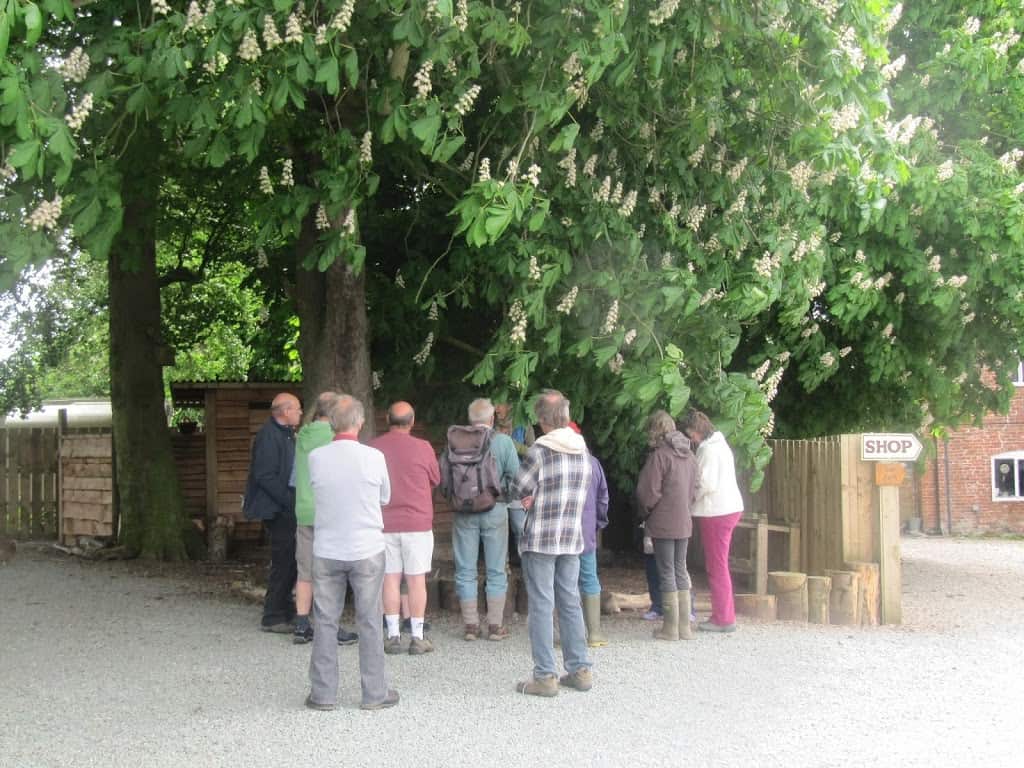 |
| Brigit telling the group how wonderful horse chestnut trees are for bees. |
Last Sunday the inspirational Brigit Strawbridge came to Fordhall to run a workshop on bees. Did you know for example, that in the UK we have 267 different species of bee? Most of these will avoid stinging at all costs, and, only one of these is the honey bee.
In fact, the smallest bee is smaller than a grain of rice! Brigit had the group awestruck as she described the different types of bee’s, where and why they choose to live in the different habitats that they do, and why different plants are more beneficial to them.
As farmers, we know how important bees are for producing food. Although, we only grow grass at Fordhall, our cattle also rely on herbs within the pastures and leaves from the surrounding trees for health. Even though bees directly pollinate a third of the food we eat and 80% of the plants on the planet you can, in fact, pretty much relate bees to almost every piece of food on your dinner plate. Their importance is exemplified in the fact that they have been around for over 100 million years – humans have only been around for 0.2 million years!
 |
| Even the dead nettles, dandelions, daisies are loved by bees |
In the morning we learned as much as we could about many different bees that can be found around us, taking tips on what we could grow in our own gardens to help reduce their decline. Then came lunch, a feast of honey roast pork, homemade honey bread and honey roasted vegetables cooked by Barney and Nicola.
To work off the delicious lunch we ventured into Fordhall’s fields to see what we could find. The excitement came when we found small holes from ground nesting solitary bees. Holes that previously none of us would even have noticed, but on inspection you can see the hard work that goes into creating them.
Every time a member of the group spotted what they thought was a bee, there was a flurry of excitement. And we weren’t always right. Some flies look like bees to avoid predation from other insects and birds. However, we were learning to spot the signs. Bee’s have large antennae, a split body, two sets of wings and smaller eyes.
Another bee was spotted feeding on the bluebells and another down near the river. Unfortunately, even at Fordhall there were less bees to see than you would expect and this is due to the wet summers and the lack of habitat across the country which is encouraging their decline.
 |
| The entrance to the home of a ground nesting solitary bee at Fordhall |
Of course, we will all be aware of the debate over pesticides within the EU and the slow stance the UK has taken on making a decision. At least, here at Fordhall we have land which is, and always will be, pesticide free, and we will do all we can to help support our British bees.
For more information see these useful websites:
Bumble Bee Conservation Trust: http://bumblebeeconservation.org/
To record your sightings: http://www.bwars.com/
Information on all insects: http://www.buglife.org.uk/
For all things Brigit Strawbridge: http://beestrawbridge.blogspot.co.uk/
Enjoy the summer and do what you can for our bees!
Charlotte

